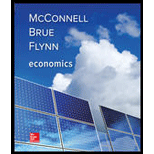
The difference between monopolistic competition and pure competition.
Explanation of Solution
Monopolistic competition and pure competition are different types of market structures. Pure competition is known as the
Monopolistic competition has a large number of buyers and sellers, whereas the pure competition has a much larger base of the buyers and sellers in the market. The monopolistic competition market is thus much smaller than the pure competition.
The monopolistic competition has differentiated products, whereas the pure competition has homogeneous products. Thus, there exists product differentiation in the monopolistic competition. The control over the market
There is no non-price competition in the pure competition whereas there is non-price competition in the monopolistic competition which ranges from the advertisement, branding, and so on. There is complete freedom of entry and exit in the pure competition whereas there is only easy entry and exit in the monopolistic competition. These are the main differences between the monopolistic competition and pure competition.
The pure monopoly and the monopolistic competition differ in many aspects of their characteristics. They can be summarized as follows:
There are a large number of sellers in the monopolistic competition compared to the single seller in the pure monopoly. There are differentiated products in the monopolistic competition, whereas there is only a single product in the pure monopoly. Similarly, the pure monopoly has complete market control compared to the limited, little control in the monopolistic competition. There are severe barriers which prevent the entry of new firms into the pure
The product differentiation means that there will be different types of products in the market. The differences can be in terms of the color, quality, quantity, shape, size, as well as the branding of the product. They help to attract the consumers to their brand and increase the
The entry of new firms into the market takes place when there is economic profit present in the market. This economic profit attracts new players into the market. As a result of the new players, there will be more products and this will reduce the demand for the existing firms. Thus, their demand curve will shift leftwards, which shows the decline in the demand for its products and as a result, their economic profit.
Concept introduction:
Monopolistic competition: Monopolistic competition is an imperfect market structure which has a relatively large number of buyers and sellers in the market, differentiated products, some control over the market price and a few barriers of entry and exit.
Pure competition: It is a market structure with a broad range of buyers and sellers which is really large, has homogeneous products, freedom of entry and exit, normal profit and no control over the market price.
Pure monopoly: Pure monopoly is an imperfect market structure where there is only a single seller. He controls the market prices and there is no entry into the market.
Want to see more full solutions like this?
Chapter 13 Solutions
Economics (Irwin Economics)
- Critically analyse the five (5) characteristics of Ubuntu and provide examples of how they apply to the National Health Insurance (NHI) in South Africa.arrow_forwardCritically analyse the five (5) characteristics of Ubuntu and provide examples of how they apply to the National Health Insurance (NHI) in South Africa.arrow_forwardOutline the nine (9) consumer rights as specified in the Consumer Rights Act in South Africa.arrow_forward
- In what ways could you show the attractiveness of Philippines in the form of videos/campaigns to foreign investors? Cite 10 examples.arrow_forwardExplain the following terms and provide an example for each term: • Corruption • Fraud • Briberyarrow_forwardIn what ways could you show the attractiveness of a country in the form of videos/campaigns?arrow_forward
 Principles of Economics 2eEconomicsISBN:9781947172364Author:Steven A. Greenlaw; David ShapiroPublisher:OpenStax
Principles of Economics 2eEconomicsISBN:9781947172364Author:Steven A. Greenlaw; David ShapiroPublisher:OpenStax Principles of MicroeconomicsEconomicsISBN:9781305156050Author:N. Gregory MankiwPublisher:Cengage Learning
Principles of MicroeconomicsEconomicsISBN:9781305156050Author:N. Gregory MankiwPublisher:Cengage Learning Principles of Economics (MindTap Course List)EconomicsISBN:9781305585126Author:N. Gregory MankiwPublisher:Cengage Learning
Principles of Economics (MindTap Course List)EconomicsISBN:9781305585126Author:N. Gregory MankiwPublisher:Cengage Learning Principles of Microeconomics (MindTap Course List)EconomicsISBN:9781305971493Author:N. Gregory MankiwPublisher:Cengage Learning
Principles of Microeconomics (MindTap Course List)EconomicsISBN:9781305971493Author:N. Gregory MankiwPublisher:Cengage Learning Principles of Economics, 7th Edition (MindTap Cou...EconomicsISBN:9781285165875Author:N. Gregory MankiwPublisher:Cengage Learning
Principles of Economics, 7th Edition (MindTap Cou...EconomicsISBN:9781285165875Author:N. Gregory MankiwPublisher:Cengage Learning Essentials of Economics (MindTap Course List)EconomicsISBN:9781337091992Author:N. Gregory MankiwPublisher:Cengage Learning
Essentials of Economics (MindTap Course List)EconomicsISBN:9781337091992Author:N. Gregory MankiwPublisher:Cengage Learning





